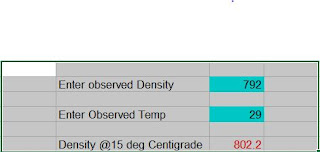- Flash Point of Kerosene at high altitude places in India
- Flash Point of Kerosene at high altitude places in India
(Revised on March 3, 2017)Effect of reduced pressure at higher altitude on flash point of petroleum products was one of my fascinating interests for years, a series of data collected, analysed, theorised, and verified over more then 14 years concluded into certain findings.
As is known qualitatively, as the location gains height the air pressure reduces and it has effect on physical properties of all liquids. Boiling point, flash point, evaporation temperature etc reduce.
Quantitatively reduction of flash point of petroleum product study at higher altitude posed limitation 15 years back due to Fortin's Barometer design specifications not suitable as written in my last post.
Even today, practically no data for flash point reduction available in internet area. Author believe the reason is flash point test was invented at sea level location, all petroleum testing labs are/were situated at sea level. Today the equipment you use for Able Flash point test is the same as the first flash point testing equipment designed by Sir Frederick Abel, as seen by author at London Science Museum in 1998.
Abel Flash point testing for Kerosene sample at 12 higher altitude locations in India, selected having increasing altitude, were carried out besides at Mumbai representing Sea level. This Kerosene sample was part of a bigger round robin programme spanning 15 nos ISO 17025 accredited petroleum laboratories and robust mean result of Flash point 38 deg C. All testing done during period of 2 years and preserving kerosene samples for maintaining physical properties. Some of the locations like Leh, Srinagar, Kullu, testing was carried out by author on 3 different dates in 2 years and mean is taken for record.
Table : Kerosene Flash Point absolute (Without Air Pressure Correction), at high Altitude places
Sr.
No
|
Place
|
Altitude
|
Atmospheric
Pressure
absolute
|
Water Boiling point
|
Kerosene
Flash
Point
|
Difference in
Flash Point
From Sea Level
|
||
meter
|
Feet
|
kPa
|
mmHg
|
C
|
C
|
C
|
||
1
|
Mumbai (sea Level)
|
3
|
10
|
101.1
|
755
|
99.9
|
38
|
0
|
2
|
Delhi
|
227
|
744
|
98.6
|
745
|
99
|
37.5
|
0.5
|
3
|
Ambala
|
264
|
866
|
98.2
|
740
|
99
|
37
|
1
|
4
|
Hyderabad
|
545
|
1780
|
95.0
|
712
|
98
|
36.5
|
1.5
|
5
|
Bangalore
|
920
|
3000
|
90.7
|
679
|
97
|
35.5
|
2.5
|
6
|
Kullu, HP
|
1,279
|
4,200
|
86.2
|
651
|
96
|
34.5
|
3.5
|
7
|
Srinagar, J&K
|
1,585
|
5200
|
83.6
|
627
|
95
|
33.5
|
4.5
|
8
|
Manali, HP
|
2,050
|
6726
|
79.0
|
592
|
93
|
32.5
|
5.5
|
9
|
Shimla, HP
|
2,206
|
7238
|
77.4
|
580
|
93
|
32
|
6
|
10
|
Kargil, J&K
|
2,676
|
8780
|
73.0
|
547
|
91
|
31
|
7
|
11
|
Leh, J&K
|
3,256
|
10682
|
67.8
|
508
|
89
|
29.5
|
8.5
|
12
|
Pangong, J&K
|
4,350
|
14,270
|
58.8
|
441
|
86
|
27.5
|
10.5
|
13
|
Khardung LA
|
5,360
|
17,580
|
51.5
|
386
|
83
|
25.5
|
12.5
|
Water boiling temperature at higher altitude locations carried out as academic activity.
Like any material testing,standard test methods are suppose to produce precision results at different places when performed on identical equipment, following slandered procedure steps, conditions and applying corrections due to changed conditions at different place, time, etc.
Able Flash point test method and other Flash point methods require change in air pressure correction and prescribe in the method itself to arrive at precision results.
The above study questions the air-pressure range given in correction formula of standard test method P:20, IP-34, IP-170 etc, the detail for it follows in next post. (- Myth of restriction of Barometer Pressure Correction formula in Flash Point test methods)
Follow me on twitter @RJPatel13 to get notification when my new post is available in my blog.

Comments